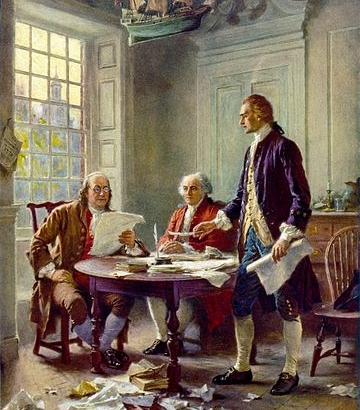From a Declaration of Independence to a Constitution: The Laws of Nature and Preservation of the United States of America
Everything comes back to the Declaration of Independence. In a way, the seeds of the Federalist Anti-federalist dispute in the framing of the Constitution were sown in the Declaration.
The Declaration of Independence established the basis of just government as consent as against the divine right of kings. To quote Thomas Jefferson, “the mass of mankind has not been born with saddles on their backs, nor a favored few booted and spurred, ready to ride them.”
Consent leads to forms of majority rule, although it must be a reasonable and restrained majority which respects the rights of the minority. Consent requires some kind of deliberation for the sake of forming consensus, and public deliberation over a proposed charter leads to disputes for and against.
But that is not the sole connection. The Declaration of Independence establishes a right of revolution. Whenever a government becomes abusive of the ends of just government it is the right of the people to alter or abolish it. Revolution is an extra-legal right. The oppressions of King George – “[a] Prince whose character is thus marked by every act which may define a Tyrant” – entitled the colonists to rebel, illegally.
The Declaration of Independence – a “unanimous Declaration of thirteen united States of America” – also stated that “That these United Colonies are, and of Right ought to be Free and Independent States.” A new nation was born that was having a hard time saying clearly whether it was one nation or many. Babes lisp, and so it was with the young United States.
The first charter of the United States was entitled the Articles of Confederation and Perpetual Union. Confederation comes from the Latin con meaning “with or together” and foederare meaning treaty or league. Again, the early babble of United States suffered some polysemy. It was a union that was perpetual but also a treaty of several states.
The Articles of Confederation, as a practical matter, were inadequate. Among other things, the new government was unable to enforce its laws directly and the scope of its powers was narrow, particularly in commercial and financial matters. The result was a chaos of creditor-debtor disputes and a moribund economy that began to threaten the viability of the United States. Both France and Britain anticipated the collapse of the new United States, and were eager to pick up the pieces.
A convention was called in 1787 to repair the defects of the Articles. The convention produced a proposal for an entirely new charter, the Constitution, to replace the Articles. The Constitution would have many new features, including drawing its authority directly from the people rather than a compact of states, exclusive coinage and bankruptcy power, and a radically new executive power embodied in a president of the United States. It also proposed that it would be deemed adopted when ratified by only nine states.
This last proposal flatly contradicted the Articles. The Articles required a unanimous vote of its member states for amendment. Like the revolution the proposal for a new Constitution, though an appeal to ballots and not bullets, was illegal.
The ground for the adoption of the Constitution was similar to that of the Revolution, an appeal to the “necessity” and (echoing the Declaration) the “law of nature and nature’s God.” The Articles were incompetent and had to be “thrown off” to for the “preservation” the country. Federalist 43.
In politics it is important to pick the name of your movement. If you do not, your political adversaries will pick it for you. The proponents of the new Constitution, led by Alexander Hamilton, James Madison and John Jay, took the name Federalist. Opposition to the new Constitution was labeled Anti-federalist, locking in rhetorical disadvantage.
Anti-federalists argued with some alarm that the new Constitution permitted the national government to resort to force. Federalists argued that the states were protected from invasion by the Federal power by their militias and from domestic insurrection or invasion by the new federal government. Federalist 28.
The Anti-federalists argued that the confederal form should have been preserved. The Federalists argued that the proposed government was “partly federal and partly national.” Federalist 39.
Anti-federalists argued that the convention did not have the authority to adopt the Constitution. The Federalists argued that the new Constitution was “necessary.” Federalist 40.
Anti-federalists argued that the proposed Constitution was too difficult to amend, and that it should be amended whenever a department of the government exceeds its authority. Federalists rebutted that frequent appeals to the people would undermine the authority and reasonableness of the new government. Federalist 49.
Anti-federalist argued that the judiciary was too independent. Federalists argued that the new Constitution’s judiciary was its least dangerous branch, and that unconstitutional judicial decisions could be ignored. Federalist 78.
The Federalists prevailed, but experience has at times exposed weaknesses in the Federalist’s arguments. The federal government has overtime supplanted the states in their power. Appeals to the people to amend their Constitution have not just become infrequent, but have ceased almost altogether: The Constitution has not been amended “soup to nuts” in more than 50 years. And this has happened as the judicial power has expanded under the doctrine of a “living constitution” to displace the amendment function; this raises the question whether the Constitution can continue to be the people’s document if the courts, and not they, are its author in key respects.
 J. Eric Wise is a partner in the law firm of Alston & Bird.
J. Eric Wise is a partner in the law firm of Alston & Bird.
Click here for American Exceptionalism Revealed 90-Day Study Schedule
Click here to receive our Daily 90-Day Study Essay emailed directly to your inbox

 https://en.wikipedia.org/wiki/United_States_Declaration_of_Independence#/media/File:Writing_the_Declaration_of_Independence_1776_cph.3g09904.jpg
https://en.wikipedia.org/wiki/United_States_Declaration_of_Independence#/media/File:Writing_the_Declaration_of_Independence_1776_cph.3g09904.jpg
 https://en.wikipedia.org/wiki/Signing_of_the_United_States_Declaration_of_Independence#/media/File:Signing_of_Declaration_of_Independence_by_Armand-Dumaresq,_c1873.png
https://en.wikipedia.org/wiki/Signing_of_the_United_States_Declaration_of_Independence#/media/File:Signing_of_Declaration_of_Independence_by_Armand-Dumaresq,_c1873.png
Join the discussion! Post your comments below.
Your feedback and insights are welcome.Feel free to contribute!